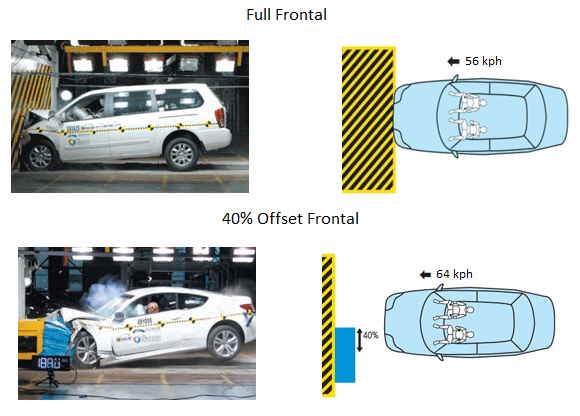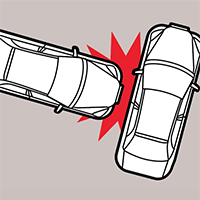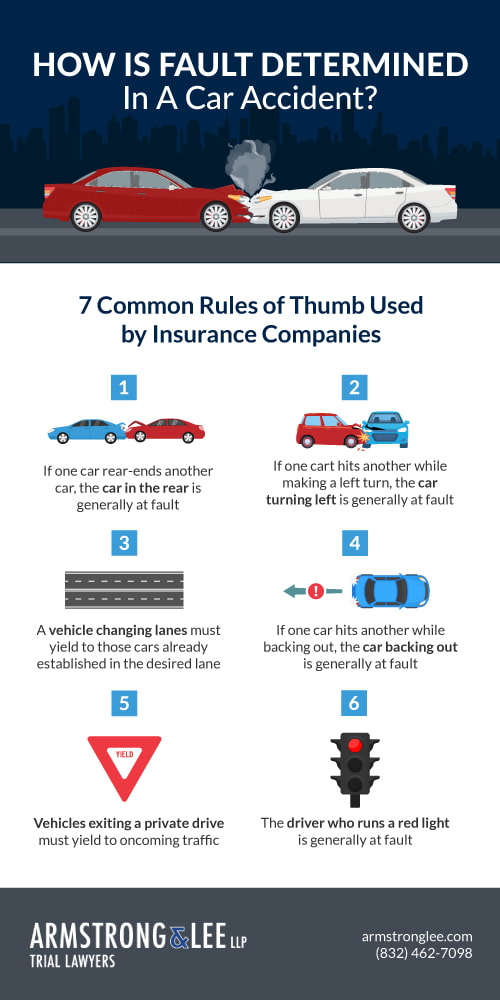Understanding the Point of Impact: What it Reveals About Car Accidents
When it comes to car accidents, one crucial aspect that investigators and insurance companies focus on is the point of impact. The point of impact refers to the specific location of a vehicle where the collision occurred. Understanding the point of impact can provide valuable insights into the dynamics of the accident and the resulting damages.
In a car accident, the point of impact can vary greatly depending on the circumstances. It could be the front, rear, side, or even multiple points of impact. Each of these scenarios can reveal different information about the accident.
- For instance, a front-end collision might indicate that the driver failed to brake in time, resulting in a rear-end collision with the vehicle in front.
- On the other hand, a side impact could suggest a failure to yield the right of way at an intersection or a driver running a red light.
Not only does the point of impact help determine who may be at fault, but it also plays a significant role in assessing the extent of injuries and damages. For example, a rear-end collision is more likely to cause whiplash or neck injuries, while a side impact can result in severe damage to the doors and potential injuries to the occupants.
Analyzing the point of impact can assist in reconstructing the sequence of events leading up to the accident. Accident reconstruction experts use this information to piece together the chain of actions and determine the speed, angles, and forces involved in the collision.
By understanding the point of impact, investigators, insurance adjusters, and legal professionals can gain a better understanding of how the accident occurred, who may be responsible, and the potential consequences for all parties involved. This knowledge is crucial for determining liability, assessing damages, and ensuring fair compensation for the victims.
In the following sections, we will delve deeper into the various types of points of impact in car accidents and the insights they provide. Understanding these details can shed light on the complex nature of car accidents and help individuals navigate the legal and insurance processes more effectively.
Significance of the Point of Impact
Understanding the significance of the point of impact in car accidents is crucial in determining the dynamics and severity of the collision. The point of impact refers to the exact location of a vehicle where the forces and energy are concentrated during a crash. It can provide valuable insights into how the accident occurred and the potential injuries sustained by the occupants.
Head-on Collisions
In a front impact or head-on collision, the point of impact is typically at the front of the vehicle, where the force of impact is concentrated. This can result in significant damage to the front end of the vehicle, including the engine compartment and crumple zones. The severity of the impact at this point can determine the level of intrusion into the passenger compartment, potentially leading to more severe injuries.

full frontal impact vs impact at an offset; image via stackexchange
Rear-end collisions
The point of impact is usually at the rear of the vehicle that was struck. This can result in damage to the bumper, trunk, or rear lights. The point of impact in these accidents can indicate the speed and force with which the striking vehicle hit the rear vehicle. It can also help determine the potential for whiplash or other neck and back injuries to the occupants of the impacted vehicle.
Side-impact collisions
Also known as T-bone or broadside collisions, have a point of impact on the side of the vehicle. This can occur at the front, middle, or rear of the vehicle, depending on the angle and location of the impact. The point of impact in these accidents can indicate the potential for serious injuries, as the side of a vehicle offers less protection compared to the front or rear.

Side-impact collision; image via geico
Implications of Points of Impact in a Collision
In car accidents, the point of impact plays a crucial role in determining the severity of the collision and the resulting damage. Understanding the different types of points of impact can provide valuable insights into how accidents occur and their implications for the parties involved.
Front Impact
This occurs when the front ends of two vehicles collide. Frontal impacts are often the most severe, as they involve a high transfer of energy. Injuries sustained in frontal impact accidents can range from whiplash to more serious head and chest injuries. Understanding the dynamics of frontal impacts can help car manufacturers improve the safety features in their vehicles, such as crumple zones and airbags.
Rear impact
This type of collision happens when one vehicle crashes into the back of another. Rear impacts commonly occur in situations such as rear-end collisions or when a driver fails to maintain a safe distance. While rear impacts may not always result in significant damage, they can still lead to injuries like whiplash, particularly for occupants in the vehicle that was struck.
Side impact
Also known as T-bone or broadside collisions, side impacts involve one vehicle crashing into the side of another. These accidents often occur at intersections when one driver fails to yield or runs a red light. Side impacts can be particularly dangerous as there is less protection for the occupants on the impacted side. Injuries from side impacts can include broken bones, head trauma, and internal injuries.
Rollover impact
Rollover accidents happen when a vehicle tips onto its side or roof. This type of impact is more common in taller vehicles like SUVs and trucks due to their higher center of gravity. Rollovers can lead to severe injuries and fatalities, as occupants may be ejected from the vehicle or crushed by the weight of the car. Understanding the causes and dynamics of rollover impacts can help in designing safer vehicle structures and implementing stability control systems.

motor vehicle rollover diagram. image via researchgate
Secondary impacts
In some accidents, there may be multiple points of impact. For example, a vehicle may collide with another and then hit a stationary object or be struck by other vehicles. Secondary impacts can exacerbate the damage and increase the risk of injuries.
How the point of impact helps determine fault in car accidents
Determining fault in car accidents can be a complex process, but one crucial factor that helps in this determination is the point of impact. The point of impact refers to the specific location of the vehicles involved where the collision occurred. It plays a significant role in understanding the sequence of events leading up to the accident and can provide valuable insights into which party may be at fault.
When the point of impact is analyzed, it helps recreate the accident scene and provides clues about the actions of each driver involved. For example, if the point of impact is at the rear end of one vehicle, it suggests that the other vehicle may have been following too closely or failed to maintain a safe distance. On the other hand, if the point of impact is on the side of a vehicle, it may indicate a failure to yield or a violation of the right-of-way.

How Is Fault Determined In A Car Accident?; image via albtriallawyers.com
The point of impact can also help determine the speed and direction of the vehicles involved. By analyzing the damage patterns and the direction of force, accident reconstruction experts can estimate the pre-impact speeds and angles of the vehicles. This information is crucial in assessing the actions and responsibilities of each driver.
It’s important to note that the point of impact alone is not the sole determinant of fault. Other factors such as traffic laws, witness statements, and evidence from the scene also come into play. However, understanding the significance of the point of impact can provide a foundation for a thorough investigation and help establish liability in car accidents.
Analyzing the point of impact to reconstruct the accident
Analyzing the point of impact is a crucial step in reconstructing a car accident. It provides valuable insights into the sequence of events leading up to the collision and helps determine who was at fault. By carefully examining the physical evidence left at the scene, accident reconstruction experts can piece together what happened and why.
One of the first things investigators look for is the location of the initial impact. This is often indicated by the damage sustained by the vehicles involved. By assessing the extent and direction of the damage, experts can make educated conclusions about the speed, angle, and force of the impact. This information is essential in understanding the dynamics of the accident.
Analyzing the point of impact can also reveal important details about the sequence of events leading up to the collision. For example, skid marks or debris patterns on the road can indicate sudden braking or swerving, suggesting that one driver may have tried to avoid the accident. Additionally, the position of the vehicles after the impact can provide clues about how the collision occurred and the movements of the drivers involved.
Accident reconstruction experts use a combination of physical evidence, witness statements, and scientific principles to recreate the accident scene. They may employ tools such as laser scanners, computer simulations, or scale models to accurately depict the sequence of events. By meticulously analyzing the point of impact and other factors, they can provide a comprehensive understanding of how the accident unfolded.
Factors influencing the point of impact
When it comes to car accidents, understanding the point of impact is crucial in determining the sequence of events and the severity of the collision. Several factors can influence the point of impact, and they play a significant role in reconstructing the accident and assessing the damage.

Factors identified to cause or interact to cause road accidents; image via researchgate
Speed
One of the primary factors is the speed at which the vehicles were traveling. Higher speeds often result in more severe impacts and can cause the point of impact to shift. Additionally, the angle of collision is critical in determining the direction and force of the impact. A head-on collision, for example, will have a different point of impact compared to a side-impact collision.
Size and Weight
The size and weight of the vehicles involved also play a role. A larger, heavier vehicle may cause more damage and push the smaller vehicle in a certain direction upon impact. The road conditions, such as wet or icy surfaces, can also influence how the vehicles interact during a collision, potentially altering the point of impact.
Human factors
Human factors, such as driver behavior and reaction time, are equally important. Distracted driving, impaired driving, or aggressive driving can all contribute to erratic movements and affect the point of impact. The position of occupants within the vehicles, seatbelt usage, and airbag deployment can also influence the point of impact and the resulting injuries.
Documenting the point of impact for insurance claims
When it comes to car accidents and insurance claims, documenting the point of impact is crucial. It provides valuable evidence that helps determine the sequence of events and who may be at fault. Insurance companies heavily rely on this information to assess the extent of damage, liability, and compensation.
By accurately documenting the point of impact, you are providing a clear visual representation of how the accident occurred. This can be done through photographs, diagrams, or even video footage if available. It is important to capture multiple angles and perspectives to ensure a comprehensive understanding of the accident scene.
Insurance adjusters and accident reconstruction specialists use this documentation to piece together the puzzle of the accident. They analyze factors such as vehicle positioning, skid marks, debris patterns, and the extent of damage to determine the speed, force, and direction of impact. This information is vital in establishing the severity of the accident and the injuries sustained by those involved.
In addition to helping with insurance claims, documenting the point of impact can also be beneficial in legal proceedings. If a lawsuit is filed, the evidence gathered from the scene can be presented in court to support your case.
Common misconceptions about the point of impact
When it comes to car accidents, there are many misconceptions surrounding the point of impact. People often assume that the point of impact is solely determined by the damage visible on the vehicles involved. However, this is not always the case.
One common misconception is that the point of impact is always the area with the most significant damage. While it is true that high-impact collisions can result in extensive damage, the point of impact can be influenced by various factors such as:
- the angle of collision
- the speed of the vehicles
- the structural integrity of the vehicles involved
Another misconception is that the point of impact is always at the front of the vehicles. While head-on collisions do often result in frontal damage, it is essential to consider other types of accidents such as side-impact or rear-end collisions. These accidents can occur at different points on the vehicles and can cause a significant impact on the overall outcome of the accident.
Furthermore, it is important to note that damage may be hidden or not immediately noticeable. This can be due to internal damage or the specific construction of the vehicles involved. Therefore, relying solely on visible damage to determine the point of impact can lead to inaccurate conclusions about the cause and severity of the accident.
Role of Technology in Assessing the Point of Impact
In recent years, technology has played a crucial role in assessing the point of impact in car accidents. This advanced technology has revolutionized accident reconstruction and provided valuable insights into the dynamics of collisions.
One such technology is the use of crash data retrieval systems (CDRS), which extract and analyze data from the vehicle’s event data recorder (EDR), commonly known as the “black box.” These devices capture critical information such as vehicle speed, brake application, throttle position, and changes in velocity leading up to and during an accident.
By analyzing the data retrieved from the EDR, experts can determine the exact point of impact and the forces involved in the collision. This information is crucial in understanding the sequence of events leading to the accident and can help establish liability.
Advanced imaging technologies such as 3D laser scanning and photogrammetry are used to create detailed and accurate models of the accident scene. These technologies allow investigators to precisely measure and reconstruct the positions of vehicles, skid marks, and other physical evidence.
Computer simulations and modeling software enable experts to recreate and analyze different scenarios to determine the most likely point of impact. These simulations take into account various factors such as vehicle dynamics, road conditions, and human behavior.
The role of technology in assessing the point of impact not only helps in determining liability but also aids in improving road safety. By understanding the factors that contribute to accidents and the specific points of impact, engineers and policymakers can develop safer road designs, implement effective traffic control measures, and design vehicles with enhanced safety features.
Professional investigation in understanding car accidents
Understanding the point of impact in car accidents can provide valuable insights into the dynamics and severity of the collision. By analyzing the location and extent of the impact, investigators and insurance adjusters can piece together the sequence of events and determine the responsible party. Additionally, knowledge of the point of impact can assist in understanding the potential injuries sustained by the occupants of the vehicles involved. Whether you are a driver, a passenger, or simply interested in road safety, understanding the significance of the point of impact is crucial. Stay informed, stay safe, and drive responsibly.